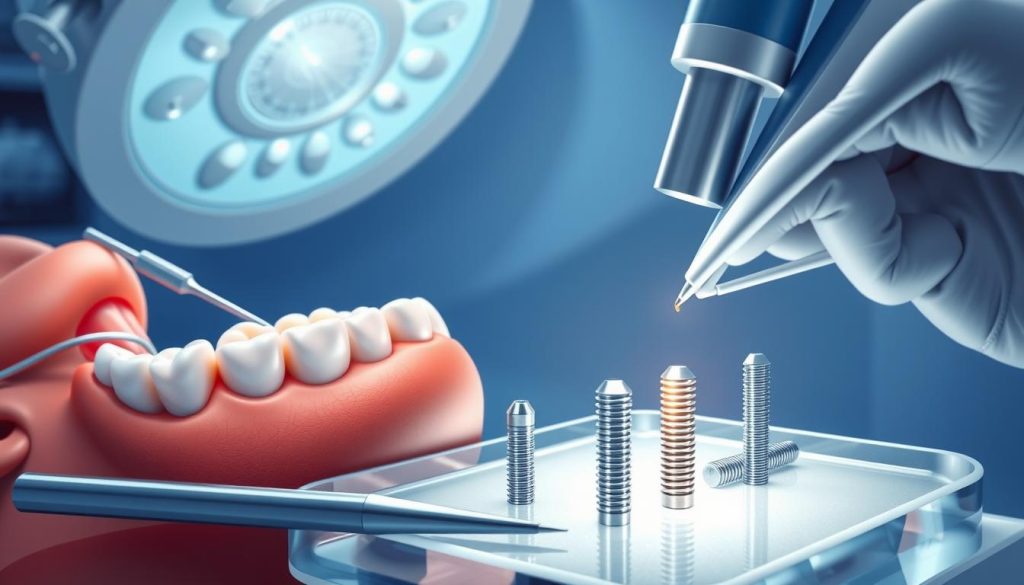Dentist surgery has made huge strides in recent years. New methods and tools have made dental care more effective and comfortable. Today, dental surgeons use the latest technology to diagnose and treat oral health issues with great precision.
Modern dentist surgery offers many solutions for different dental problems. From implants to root canals, these treatments not only fix oral health but also improve smiles. Now, patients can choose from minimally invasive procedures that lead to quicker recovery times and better results.
As dental technology keeps improving, it’s important to stay updated on the latest in dentist surgery. Knowing about these advancements helps patients make informed choices for their oral health and overall well-being.
Understanding Modern Dental Surgery Procedures
Dental surgery has changed a lot over the years. Today, procedures are more precise and less painful. They focus on making patients comfortable. Let’s look at how dentist surgery has evolved and the new technologies that have changed the field.
Evolution of Dental Surgical Techniques
Those long, painful dental procedures are a thing of the past. Now, dentist surgery uses new, less invasive methods. These methods help patients recover faster and get better results.
Microsurgery tools help doctors work with great accuracy. This means they can save more of the natural tooth. Laser technology has also changed soft tissue procedures. It reduces bleeding and speeds up healing.
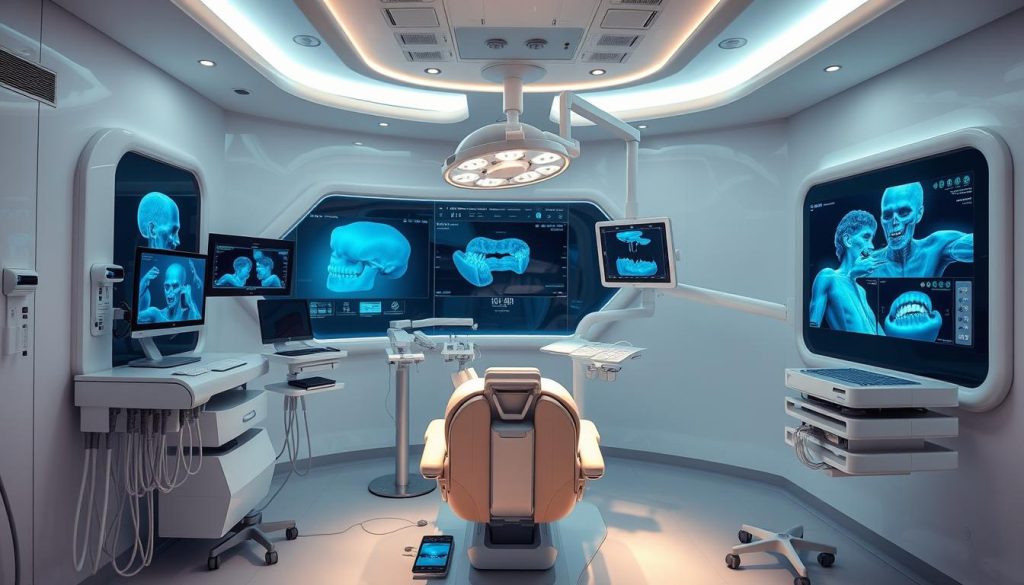
Role of Technology in Modern Dentistry
Technology is key in making dentist surgery better. 3D imaging gives doctors clear views of teeth and gums. This helps them plan treatments more accurately.
Computer-aided design and manufacturing (CAD/CAM) systems make custom restorations in one visit. Soon, robotic-assisted surgeries will offer even more precision in complex cases.
Patient Safety and Comfort Innovations
Today, making patients comfortable is a top priority in dentist surgery. New anesthesia techniques mean procedures are pain-free. Dental sedation helps anxious patients through complex surgeries.
After surgery, care has improved too. Better pain management and personalized recovery plans are now standard. These changes have made dental surgery more comfortable and less scary for patients.
“The advancements in dental surgery have not only improved treatment outcomes but have also significantly enhanced the patient experience,” says a leading dental surgeon.
Comprehensive Guide to Dental Implants
Dental implants have changed the game for tooth replacement. They offer a lasting fix for missing teeth. These artificial roots support fixed or removable teeth that look and feel like your own.
The process of getting implants starts with removing the damaged tooth. Then, the jawbone is prepared for surgery, which might include a bone graft. After the jaw heals, the oral surgeon inserts the metal post into the bone. Healing times vary based on the individual.
There are two main types of dental implants:
- Endosteal implants: Placed directly into the jawbone
- Subperiosteal implants: Placed under the gum but on or above the jawbone
Not everyone can get dental implants. You need healthy gums and enough bone to support the implant. Heavy smokers, people with chronic diseases, or those who’ve had head/neck radiation should be checked individually.
Dental implants bring many long-term benefits:
- Improved appearance and speech
- Comfort and easier eating
- Durability and convenience
- Better oral health
While implants have a high success rate, they can fail. This can happen due to infection, fracture, or too much stress. Keeping up with dental check-ups and good oral care is key to keeping your implants healthy.
Advanced Root Canal Treatments and Technologies
Root canal treatment has evolved a lot. The old days of long, painful procedures are gone. Now, we have modern methods that are more comfortable and effective.
Modern Root Canal Procedures
Dentists use microscopes and 3D imaging today. These tools help them find and clean all canals accurately. Rotary instruments also clean faster and better than old methods.
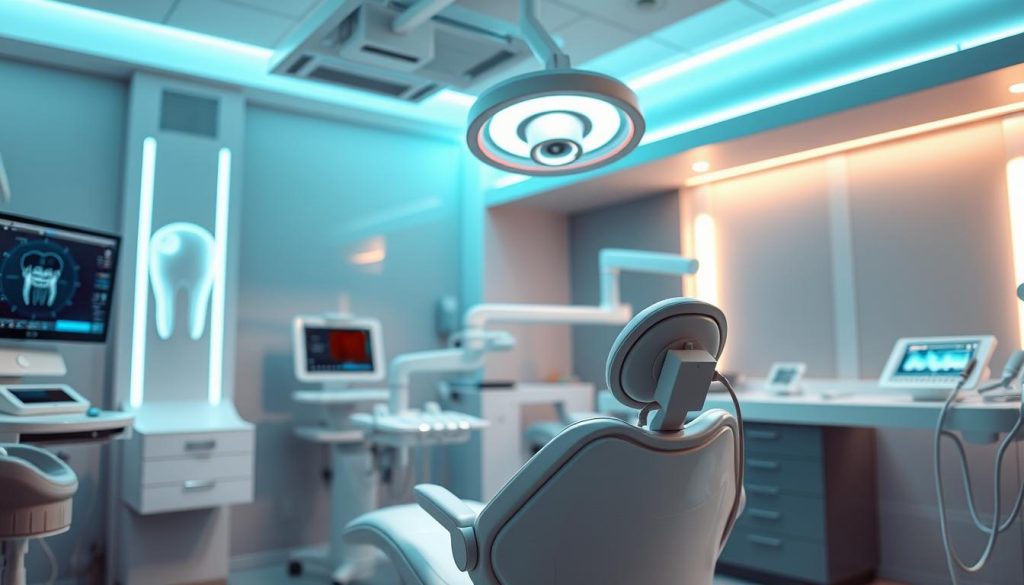
Recovery and Aftercare Guidelines
Recovery from a root canal is usually quick. Most people can go back to their daily activities the next day. To help with healing:
- Avoid chewing on the treated tooth until it’s fully restored
- Take any prescribed medications as directed
- Brush and floss gently around the area
- Make sure to attend follow-up appointments
Benefits of Contemporary Root Canal Methods
Modern root canal treatments have many benefits:
- Less pain during and after the procedure
- Healing happens faster
- The natural tooth structure is better preserved
- There’s a higher chance of saving the infected tooth
These advancements make root canal treatment a reliable choice for saving teeth that might need to be pulled.
Professional Teeth Whitening Solutions
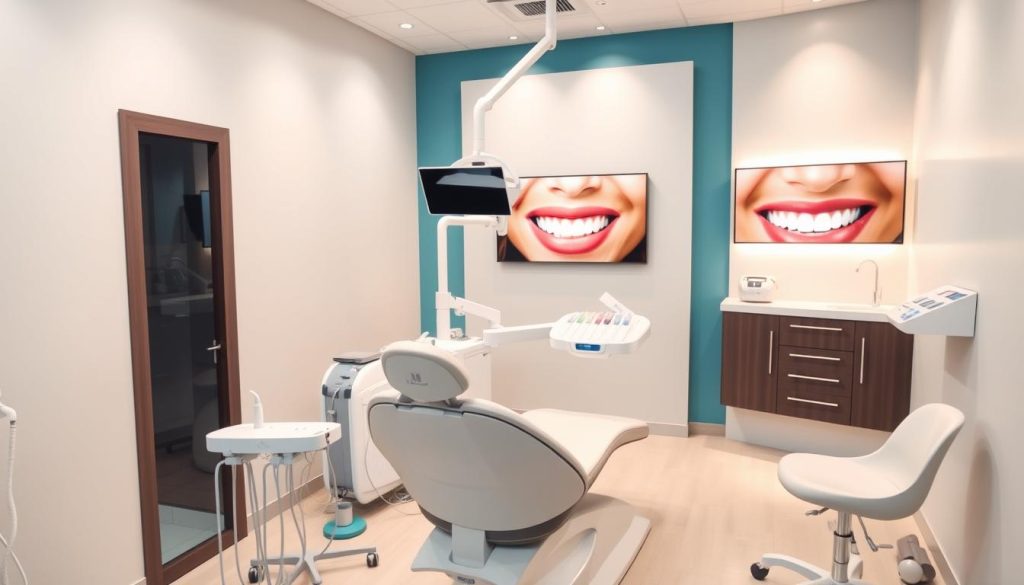
Teeth whitening is now a common choice for people looking to improve their smile. Professional treatments give better results than products you can buy yourself. Dental offices offer two main options: in-office treatments and take-home kits.
In-office whitening uses a strong bleaching gel on your teeth. The dentist uses lights or lasers to make it work faster. This can make your teeth several shades whiter in just one visit.
Take-home kits include custom trays and professional whitening gel. You use the gel at home for a set time each day. These kits take longer to show results but are easy to use and improve your smile slowly.
| Treatment Type | Duration | Results | Cost Range |
|---|---|---|---|
| In-Office | 1-2 hours | Immediate | $500-$1000 |
| Take-Home Kit | 1-2 weeks | Gradual | $300-$600 |
Professional teeth whitening is safe when done by a dentist. You might feel some tooth sensitivity at first. To keep your teeth white, avoid foods that stain, brush well, and get regular cleanings.
Contemporary Orthodontic Treatment Options
Orthodontic treatments have evolved a lot in recent years. Today, we have more comfortable and efficient options than ever. Let’s look at the latest ways to straighten teeth and enhance smiles.
Traditional vs. Clear Aligners
The choice between traditional braces and clear aligners is a common debate. Metal braces are great for complex cases. Clear aligners are a discreet choice for less severe issues. Both are important in today’s orthodontics.
| Feature | Traditional Braces | Clear Aligners |
|---|---|---|
| Visibility | Noticeable | Nearly invisible |
| Removability | Fixed | Removable |
| Treatment Time | 18-24 months | 12-18 months |
| Cleaning | Challenging | Easier |
Digital Orthodontic Planning
Digital planning has changed orthodontic care. 3D scans make precise tooth models. This leads to custom treatment plans. Patients can even see their future smile before starting treatment.
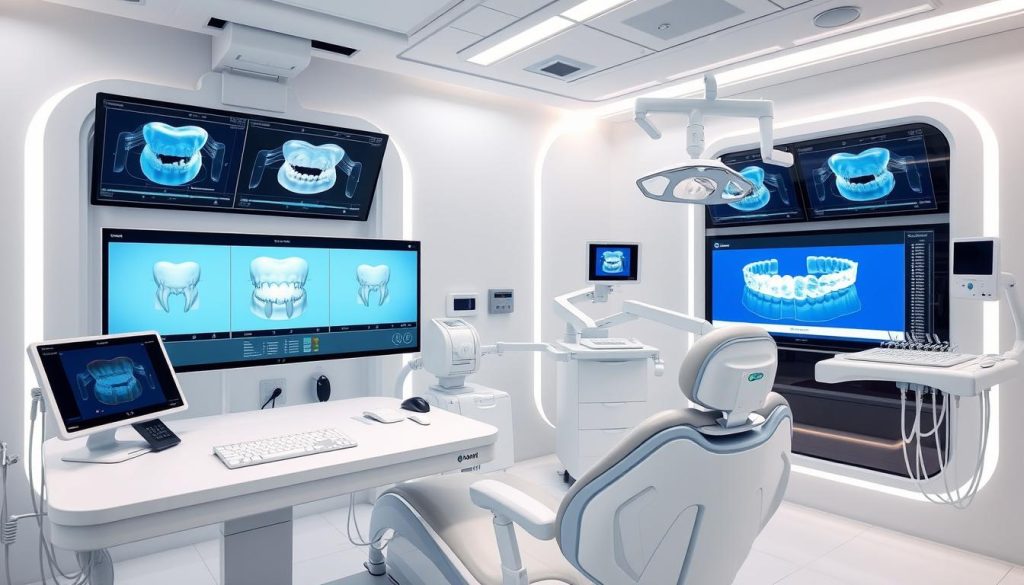
Treatment Duration and Expectations
Treatment times differ based on individual needs. Simple cases might take a few months. More complex cases could need two years or more. Being patient is important for the best results with braces. Regular check-ups help keep treatment on track.
“With modern orthodontic techniques, we can achieve remarkable results in less time and with greater comfort than ever before.”
Knowing about these options helps patients make better choices for their orthodontic care. The best way to find the right treatment is to talk to a qualified orthodontist.
Wisdom Teeth Extraction: Modern Approaches
Removing wisdom teeth has changed a lot in recent years. Dentists now use advanced imaging to plan extractions with great care. This reduces risks and makes the process better.
3D scans give dentists a clear view of the teeth and the area around them. This helps them create treatment plans that fit each patient perfectly.
Today’s surgery for wisdom teeth is much different. Doctors use smaller cuts and special tools to remove the teeth. This makes the process less painful, heals faster, and lowers the chance of problems.
- Precise 3D imaging for accurate planning
- Minimally invasive surgical techniques
- Faster recovery times
- Reduced post-operative discomfort
After the surgery, taking care of yourself is key. You’ll get clear instructions on how to handle swelling, pain, and keeping your mouth clean. Using cold compresses and over-the-counter pain meds can help with pain. For a few days, it’s best to eat soft foods.
| Traditional Extraction | Modern Extraction |
|---|---|
| Longer recovery time | Faster healing |
| More post-operative pain | Reduced discomfort |
| Higher risk of complications | Improved safety profile |
| Limited pre-operative planning | Precise 3D imaging guidance |
Dentists today use new methods to make wisdom teeth removal safer. They use special tools and better ways to stitch wounds. This means patients bleed less and have a lower chance of getting dry socket, a painful issue after tooth removal.
Comprehensive Gum Disease Management
Gum disease treatment has made big strides in recent years. Dental experts now use advanced methods to fight periodontal issues. These methods help restore gum health and prevent future problems.
Surgical Treatment Options
When other treatments don’t work, surgery is needed. Flap surgery and bone grafting are common. Flap surgery lifts the gums to remove tartar. Bone grafting helps grow back lost bone and tissue.
Laser Therapy Applications
Laser technology has changed gum disease treatment. It’s precise, reduces bleeding, and heals faster. Lasers can remove infected tissue and help gums grow back.
Prevention and Maintenance Strategies
Preventing gum disease is key for good oral health. Brushing, flossing, and dental visits are essential. Professional cleanings remove plaque and tartar that home care might miss.
| Treatment Type | Benefits | Recovery Time |
|---|---|---|
| Flap Surgery | Deep cleaning, bone reshaping | 1-2 weeks |
| Laser Therapy | Minimally invasive, less pain | 24-48 hours |
| Bone Grafting | Restores lost bone, supports teeth | 2-3 weeks |
Eating a balanced diet with vitamins C and D helps gums. Quitting smoking also lowers gum disease risk. With the right care and dental visits, you can keep your gums healthy for life.
Advanced Dental Crown Procedures
Dental crowns have evolved a lot in recent years. Now, patients have more choices and better outcomes. The use of CAD/CAM technology has changed how crowns are made. It allows for same-day treatments in many cases.
Today, crowns are made from different materials, each with its own benefits:
- Porcelain: Natural-looking and durable
- Ceramic: Strong and aesthetically pleasing
- Metal alloys: Extremely long-lasting
- Zirconia: Combines strength and appearance
Dentists pick the best material based on several factors. These include where the tooth is, the patient’s bite, and what they want it to look like. Getting dental crowns involves several steps:
- Tooth preparation
- Digital impressions
- Crown fabrication
- Fitting and cementing
It’s important to take good care of dental crowns to make them last. This means brushing, flossing, and regular dental visits. With proper care, modern crowns can last 15 years or more.
| Crown Type | Durability | Appearance | Cost |
|---|---|---|---|
| Porcelain | Good | Excellent | High |
| Metal | Excellent | Poor | Moderate |
| Zirconia | Excellent | Very Good | High |
These new advancements in dental crown technology offer better looks, comfort, and durability. Knowing about these options helps patients make better choices for their dental health.
State-of-the-Art Cosmetic Dentistry
Cosmetic dentistry has made huge strides in recent years. New methods and tools now make it possible to achieve stunning smiles. Let’s dive into some of the latest advancements in this field.
Veneers and Bonding Techniques
Dental veneers are thin, custom-made shells that cover the front of teeth. They can fix chips, cracks, and stains. Modern veneers are made from strong porcelain that looks just like natural teeth. Bonding, on the other hand, uses a tooth-colored resin to reshape teeth. Both methods offer quick and dramatic results.
Smile Design Technology
Digital smile design lets patients see their new smile before it’s done. Dentists use 3D imaging to plan the perfect smile. This technology ensures patients get exactly what they want. It removes the uncertainty from cosmetic dentistry.
Long-term Results and Care
Cosmetic dental work can last for many years with the right care. Patients should:
- Brush twice daily with non-abrasive toothpaste
- Floss daily to remove plaque
- Avoid biting hard objects
- Visit the dentist regularly for check-ups
With good habits, a beautiful smile can stay bright for a decade or more.
Cosmetic dentistry offers powerful tools to transform smiles. From veneers to digital planning, these treatments can boost confidence and oral health. Patients should talk to a qualified dentist to find the best option for their needs.
Emergency Dental Surgery Services
Dental emergencies can happen anytime, causing pain and worry. It’s important to know when to get emergency dental care. Quick action can save or lose a tooth.
Common dental emergencies include severe toothaches, knocked-out teeth, and broken or chipped teeth. These need fast help from a dentist. Emergency dental care services are available 24/7 to quickly fix urgent problems.
If you have a dental emergency:
- Stay calm and check the situation
- Rinse your mouth with warm water
- Use a cold compress to lessen swelling
- Call an emergency dentist right away
Preventing dental emergencies is important. Regular dental visits, good oral care, and wearing protective gear in sports can help. Remember, getting emergency dental care on time can avoid big problems and expensive treatments later.
| Emergency | Action | Time Sensitivity |
|---|---|---|
| Knocked-out tooth | Keep in milk or saliva | Within 30 minutes |
| Severe toothache | Rinse with warm water | Within 24 hours |
| Broken tooth | Save pieces, rinse mouth | Same day |
Understanding dental emergencies and how to react can protect your smile and oral health. Don’t wait to get professional help for urgent dental problems.
Digital Imaging in Dentist Surgery
Digital imaging has changed dentist surgery for the better. It makes treatments more precise and care for patients better. This tech lets dentists see and plan treatments with great accuracy.
3D Scanning Applications
3D scanning gives dentists a detailed look at a patient’s mouth. They use these scans to make custom treatments and prosthetics. The whole process is fast, comfy, and very accurate.
- Improved diagnosis of dental issues
- Better planning for complex procedures
- Enhanced patient understanding of treatments
- Reduced need for physical impressions
Computer-Guided Surgery Planning
Computer-guided planning is taking dentist surgery to new levels. It uses 3D scans to make detailed surgical guides. These guides help dentists do procedures more accurately and with less invasion.
| Feature | Traditional Method | Computer-Guided Method |
|---|---|---|
| Accuracy | Moderate | High |
| Surgery Time | Longer | Shorter |
| Patient Comfort | Variable | Improved |
| Recovery Time | Longer | Shorter |
Digital imaging in dentist surgery keeps getting better. It promises even more precise and patient-friendly treatments in the future.
Sedation Options in Modern Dental Procedures
Dentist surgery has made big strides in making patients comfortable. Now, there are many sedation options for stress-free visits. These range from light relaxation to deep sleep during complex procedures.
Nitrous oxide, or laughing gas, is a mild sedation. It’s great for those with a bit of anxiety. Oral sedatives offer deeper relaxation and are taken before your visit. For more detailed procedures, IV sedation is available. This lets the dentist adjust the sedation as needed.
General anesthesia is used for the most complex surgeries. It’s often needed for wisdom tooth removal or big oral reconstruction. Your dentist will pick the best option for you based on your health and the procedure.
| Sedation Type | Level of Sedation | Best For |
|---|---|---|
| Nitrous Oxide | Mild | Routine cleanings, fillings |
| Oral Sedatives | Moderate | Root canals, extractions |
| IV Sedation | Deep | Implant surgery, multiple extractions |
| General Anesthesia | Unconscious | Complex oral surgery |
Safety is key in sedation dentistry. Dentists get special training to use sedatives. They watch your vital signs during the procedure. This makes sure you’re comfortable and safe during dentist surgery.
Post-Surgical Care and Recovery Guidelines
Proper care after dental surgery is key for a smooth recovery. Whether you’ve had dental implants or root canal treatment, these guidelines will help. They ensure optimal healing and minimize complications.
Pain Management Protocols
Managing discomfort after dental procedures is important. Your dentist may give you pain medication or suggest over-the-counter options. Ice packs on your cheek can help with swelling and numbness.
For dental implants, avoid touching the surgical site to prevent irritation.
Dietary Recommendations
Stick to a soft diet after dental surgery. Start with cool, liquid foods, then move to softer solids. After a root canal, avoid chewing on the treated tooth until it’s fully restored.
For dental implant patients, avoid hard or crunchy foods. This helps protect the healing site.
Follow-up Care Schedule
Regular check-ups are vital for monitoring your recovery. Patients usually return within a week of their procedure. Those with dental implants may need several visits to check osseointegration.
Root canal treatment often requires a final visit to place a permanent crown. Following your dentist’s recommended schedule ensures proper healing and long-term success of your dental work.
- Keep the surgical area clean
- Take prescribed medications as directed
- Avoid smoking and alcohol consumption
- Rest and limit physical activity for the first few days
By following these post-surgical care guidelines, you’ll set yourself up for a successful recovery. You’ll also achieve optimal oral health outcomes.
Insurance and Financial Considerations
Dental care can be expensive, including cosmetic dentistry and dental crowns. It’s key to know about insurance and financial help. Many plans cover basic care but might not cover more complex treatments.
Dental insurance has different levels of coverage. Preventive care like cleanings and X-rays are usually fully covered. Fillings might get 80% coverage. But, dental crowns could only get 50% coverage. Cosmetic dentistry is rarely covered.
If insurance doesn’t cover a treatment, dental offices often have other options. You might find payment plans, healthcare credit cards, or third-party financing. It’s smart to talk about these with your dentist before starting treatment.
| Procedure | Average Cost | Typical Insurance Coverage |
|---|---|---|
| Dental Crown | $800 – $1500 | 50% |
| Teeth Whitening | $300 – $1000 | Not covered |
| Dental Implant | $3000 – $4500 | Partially covered |
To get the most from your insurance, plan big procedures for two years. This way, you can use your annual max twice. Always check with your insurance to know what’s covered and what’s not before any dental work.
Choosing the Right Dental Surgeon
Finding the right dental surgeon is key for a successful surgery. This guide will help you choose the best for procedures like wisdom teeth removal.
Qualifications and Certifications
Look for dental surgeons with the right credentials. Board certification shows they’ve had advanced training. Make sure they keep their skills sharp with ongoing education.
Experience and Specializations
Experience matters, even more for complex procedures. Surgeons who specialize in your procedure might do better. Ask about their success and how often they do your procedure.
Patient Reviews and Success Rates
Check out patient reviews to see how happy they are. High success rates and positive feedback mean a skilled surgeon. Ask for before-and-after photos of similar cases.
| Factor | Importance | How to Verify |
|---|---|---|
| Board Certification | High | Check dental board websites |
| Years of Experience | Medium | Ask during consultation |
| Specialization | High | Review surgeon’s profile |
| Patient Reviews | Medium | Read online testimonials |
| Success Rates | High | Request during initial meeting |
By looking at these factors, you can find a dental surgeon who fits your needs. This ensures the best outcome for your surgery.
Latest Innovations in Dental Surgery Equipment
The world of dental surgery is changing fast with new technologies. Laser equipment is now key in treating gum disease. It offers precise and less invasive treatments.
These advanced lasers can target problem areas without harming healthy tissue. This leads to quicker healing times for patients.
3D printing has changed dental care, making custom implants and prosthetics possible. It creates exact replicas of patients’ teeth. This ensures a perfect fit and natural look.
In teeth whitening, new LED-activated systems work faster and more effectively. They give patients brighter smiles in less time.
Robotic assistance in dental surgery is becoming more common. It enhances the precision of complex procedures. These robots work alongside dentists, helping to place implants with incredible accuracy.
The mix of human expertise and robotic precision leads to better outcomes. It also reduces recovery times for patients undergoing dental surgeries.
FAQ
Q: What are the most common dental surgery procedures?
A: Common dental surgeries include dental implants, wisdom teeth removal, root canals, and gum disease treatment. These help fix various oral health problems. They improve dental function and overall health.
Q: How long does it take to recover from dental implant surgery?
A: Recovery from dental implant surgery is quick. Most people can go back to normal in a few days. It takes 3-6 months for the implant to fully bond with the jawbone. Recovery time varies based on health and the number of implants.
Q: Is root canal treatment painful?
A: Root canal treatment is not painful today. Thanks to new techniques and anesthesia, most feel little to no pain. After, some soreness might happen, but it’s usually managed with over-the-counter pain meds.
Q: How long do the results of professional teeth whitening last?
A: Teeth whitening results can last 6 months to 2 years. This depends on oral care, diet, and lifestyle. Regular touch-ups and good care can extend the results.
Q: Are clear aligners as effective as traditional braces?
A: Clear aligners, like Invisalign, work well for many cases. They’re good for mild to moderate alignment issues. But, complex problems might need traditional braces. An orthodontist can advise the best option.
Q: What are the signs that wisdom teeth need to be removed?
A: Signs for wisdom teeth removal include pain, swelling, and trouble opening the mouth. Regular dental visits can catch issues early.
Q: How is gum disease treated?
A: Gum disease treatment varies by severity. Early stages might need cleaning and better oral hygiene. Advanced cases might need scaling, antibiotics, or surgery.
Q: How long do dental crowns last?
A: Dental crowns last 10 to 15 years on average. With good care, they can last longer. Factors like hygiene, bite forces, and crown material affect longevity.
Q: What are the most popular cosmetic dentistry procedures?
A: Popular cosmetic dentistry includes whitening, veneers, bonding, and smile makeovers. These address many aesthetic concerns, helping achieve the desired smile.
Q: What constitutes a dental emergency?
A: Dental emergencies include severe pain, knocked-out teeth, and bleeding. They also include swelling and broken teeth. Immediate care is needed to prevent further issues and pain.












